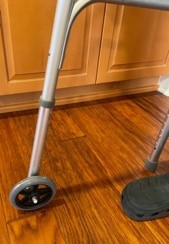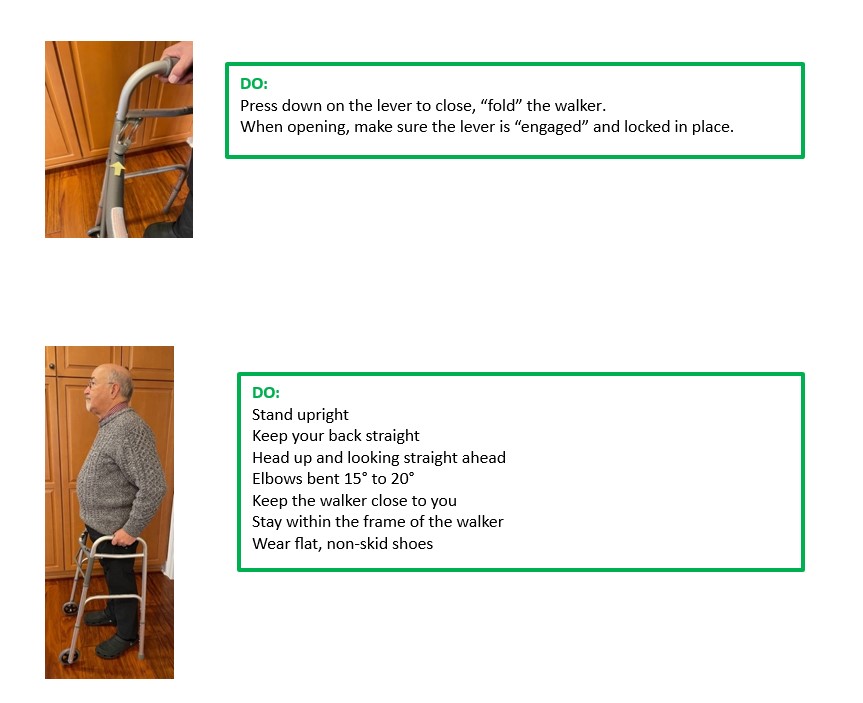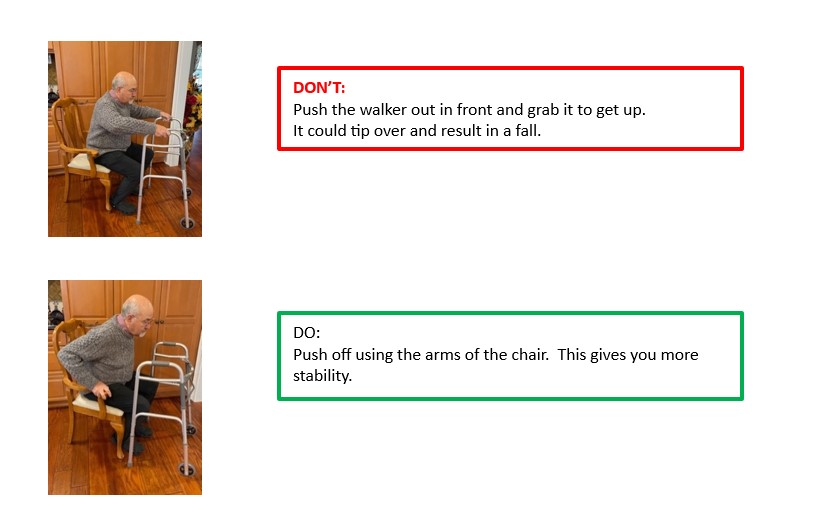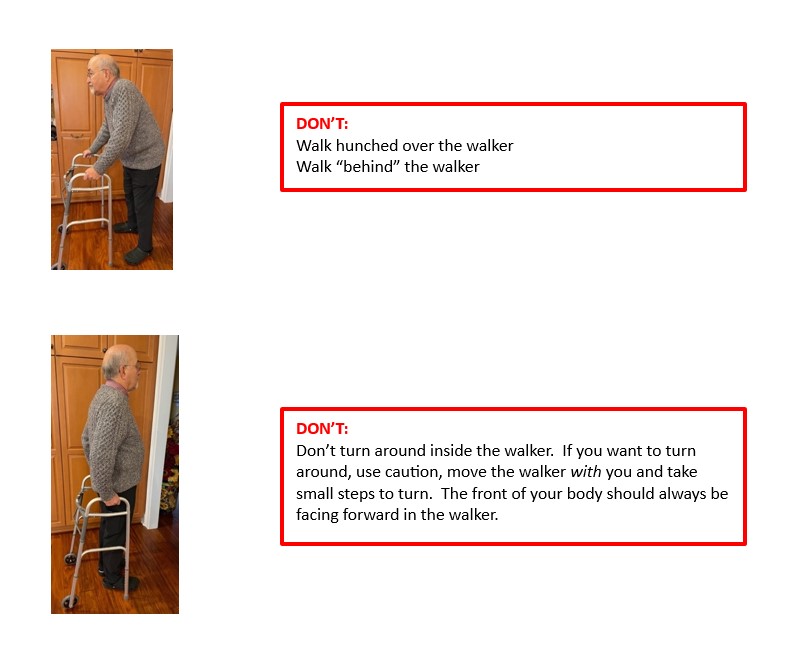This need for new medical equipment may come at a time when you are already feeling in over your head,
overwhelmed with one more thing to plan, and you’re trying hard to be a great advocate for your loved one.
It can leave you wondering about
- what “features” you need,
- what is the safest option for your loved one, and
- what is the cost?

Let’s start by looking at this as you would buying a car. For one thing, it’s better to contemplate buying before you need it, rather than, in the instance of a vehicle, when you’re stranded on the side of the road.
Things to Consider:
WHY are you buying a walker?

Is it for temporary or for permanent use?
Will it be used indoors, outdoors or both?
Is it mainly for balance/support for short periods of walking, or for longer periods
when the user may need to sit?
If your loved one is a resident in an assisted living facility or skilled nursing facility, you may need to consult an outside physical or occupational therapist. If your loved one is being discharged from the hospital, they may provide you with a walker, or give you suggestions as to what would be the best option.
Here are the types of WALKERS you may come across:
- Standard – has four legs, no wheels. It must be picked up to move, and may be called a pick up walker. It has rubber tips on the bottom of each leg.

- Wheeled – has two wheels in the front. These are the ones you usually see with tennis balls on the back legs, which helps to prevent scratching the floor.

- Rollator – has four wheels, hand brakes and usually a seat, with or without a pocket/basket

- Upright – this is a taller walker with higher arm supports so the majority of the weight is borne on the forearms rather than the hands and wrists. May also be referred to as a gutter frame walker.

- Hemi–walker – used by those who can use one hand/arm, not both, for support

- 3-wheel walker – some say it’s easier to maneuver, others say it’s not as safe as other walkers

- Knee walker/Knee scooter – used for those with foot and/or ankle injuries, post operative mobility

To return to my car buying analogy: Try it before you buy it and look at the features and capabilities.

Some additional considerations include:
- Will it fit in your car?
- Can your loved one, or you, lift it in and out of your car?
- Does it have so many features it’s confusing to use?
- For those with arthritic hands and/or little grip strength:
Is your loved able to open and close the walker? In the image below you can see the little lever that
must be pushed down to unlock and close the walker. It can be difficult to manipulate, some
walkers requiring pushing both levers at the same time.

- Will the walker fit through doorways? (…in your home, into the bathroom, in the facility)?

- Are the grips comfortable, and non-slip?
- Is the seat comfortable?
This is important if the walker will be used as a seat for a longer period of time such as at a restaurant or at a movie.
Proper Fit of a Walker
Proper fit can help ensure stability, balance and comfort. An improperly fitted walker or improper use can cause unnecessary discomfort, especially in the arms, shoulders and back.





Additional Safety Precautions:
Ensure that the brake is ON before sitting down in the walker.
Don’t push the walker way out in front of you.
Check the rubber tips and change them when they start to become worn.
Comparison of different types of walkers. Do consult with your physician, an occupational therapist or physical therapist for best results, and for help making your buying decision.
| Standard | Wheeled | Rollator | Upright | Hemi | 3- Wheel | Knee | |
| Wheels | None | 2 | 4 | 4 | None | 3 (front rotates) | 4 |
| Wheel diameter | None | 5” | 6” or 8” | 10” | None | 8” | 7.5” |
| Brake | None | None | Yes | Yes | None | Yes | Yes |
| Seat | No | No | Yes | Yes | No | Some do | No |
| Pocket/Basket | No | No | Yes | Yes | No | Some do | Yes |
| Padded grips | Yes | Yes | Yes | Yes | Yes | Yes | Pad = 7” |
| Material | Aluminum | Aluminum | Steel | Aluminum | Aluminum | Aluminum | Steel |
| Weight | 6.6 lb | 7.5 lb | 19 lb | 22 lb | 3.5 lb | 13.8 lb | 21.9 lb |
| Foldable | Yes | Yes | Yes | Yes | Yes | Yes | Yes |
| Max height | 37” | 39” | 35” | 47” | 34.5” | 37” | 38” |
| Weight capacity | 350 lb | 350 lb | 350 lb | 300 lb | 300 lb | 250 lb | 300 lb |
| Adjustable | Yes | Yes | Yes | Yes | Yes | Yes | Yes |
| Cost* | $39 | $39 | $75 | $150 | $48 | $130 | $144 |
*This is only an estimate after doing an internet search.
Accessories: (You can think of these as “add-ons” like when buying a car)!
pocket/basket carry hook cup holder
drink holder phone holder tray table
tote bag cane holder umbrella holder
tennis ball glides oxygen (O2) tank holder
WHERE do you buy a walker?
- Medical Supply Store
Call first to make sure they have walkers in stock, and out of the box, that you can look at and try out
Ask about warranty and repair
Ask if they have someone who can “fit” the walker
- Large pharmacy chains (CVS, Rite Aid, Walgreens)
- Thrift/Resale Stores
From time-to-time thrift and resale stores will get in used medical equipment.
Be sure to check that the item you are buying is in good working order and will be safe to use.
Purchase at your own risk.
(I was fortunate enough to find a wheelchair for my dad at a local, large, non-profit resale store. The donor’s parent had just died and the wheelchair was brand new. The price was good: I carefully checked it over before I bought it. It was an unusual and serendipitous find).
- Check with your Social Worker, Discharge Planner or physician for other sources
- If you need a walker for short term use, check with friends, family, business associates to see if you could borrow one. You may also wish to rent. Again, check to make sure it is in good working order before you use it.
- After some surgeries/injuries, your loved one may be sent home with a walker which they may keep.
How do you PAY for a walker?
- Medicare
This involves meeting certain criteria. For example, you’ll likely need a prescription from a physician.
Medicare-approved durable medical equipment (DME) store/supplier
Google: medicare.gov supplier directory
- Your insurance company
- Private pay
- SAVE any and all receipts
If you have time, it’s worth it to make phone calls, visit places which sell walkers and give them a test drive. Make notes, ask questions, and ask for and keep business cards. If your loved one wishes to be involved, they can choose a walker, and with some, can even choose a color.
After buying, be sure to label the walker with their name and your phone number.
Note: If one of their belongings go missing, be sure to check in the pocket – you might be amazed by what you find in there!
Good Luck and continue to advocate!
You’re doing a great job!

NOTE: The information in this Blog: Buying and Using a Walker – What You Need to Know is based on my own experience using a walker and assisting my parents with buying and using a walker. I am not a Physical Therapist and am passing along these tips as helpful information. Please consult a professional for more details.
